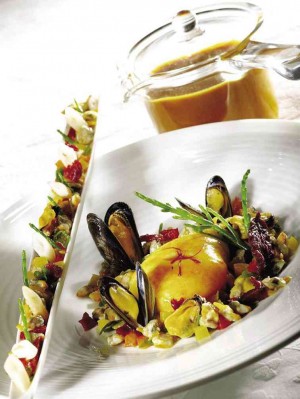
The chef sitting across from me, Nicolas Isnard, is not happy. He lets out a dismissive snort and counts on his fingers. “There are 500 one-star restaurants in France. You had one bad experience and you say French cuisine is down, that it’s no longer important?”
We are sitting beside each other at one of the most quiet tables at Tivoli Grill, where I have just finished his menu degustation, and he has just ended lunch service.
The meal from the one-star guest chef of the Mandarin Oriental Manila that I have just finished has been superb, not just delicious but well-planned and precisely executed, with not a false note. It is intelligent: logical and creative at the same time.
My wife and I have eaten not just at Michelin-star restaurants but also in bistros, brasseries and cafés and have come away disappointed. Why didn’t I get to eat meals like this in Paris when I went there earlier this year?
“It’s different nowadays,” says Isnard, “you have to choose carefully. You have to do research, look at the Internet, ask other chefs…”
The days when the Guide Michelin was all you needed are over, more specifically because the kind of meal you could expect from a one-star Michelin restaurant is so varied nowadays.
“Some restaurants are like museums,” explains Isnard. “Like Paul Bocuse, he has three Michelin stars, and he is still cooking as he did 30 years ago. Foreigners come and they love it, they say this is the real cuisine Français. But other chefs are trying to innovate, to do something different.”
There was a time when it was difficult to get a bad meal in Paris, that chefs never strayed very far from the classics, and at a starred restaurant you knew more or less what you were going to get.
Today the Michelin guide is considered to be a bit of a relic and a lot less relevant than it used to be; the much less Franco-centric list (some would even go so far as to say anti-French) of the 50 Best Restaurants in the World, sponsored by San Pellegrino.
This year, El Celler de Can Roca in Spain has dislodged Noma as the No. 1 restaurant in the world.
“It’s not that France is going down,” says Isnard. “It’s that the other countries are going up. And so people get excited, 10 years ago it was all Spanish food, molecular cuisine. And now it’s Scandinavia. You know the San Pellegrino guide, of course. It says Joan Roca and Rene Redzepi are the best chefs in the world; I think maybe, maybe not… But for sure, molecular cuisine is finished. It’s over.”
No more foams
What, no more foams and emulsions?
News of its death doesn’t seem to have reached us here, where there are at least three restaurants that would call themselves “modernist” in their approach. Is the trend for modernist cuisine as ephemeral as all those bubbles themselves?
“No, no, I enjoy all these restaurants, and I use their techniques, as I told you.”
Earlier I asked Isnard for the recipe for his mashed potatoes, which has the same rich butteriness as the Robuchon recipe but is light and foamy, almost sauce rather than starch, indubitably the result of a nitrous oxide siphon.
I venture that molecular cuisine is a culinary movement created for the camera, the goal being the ultimate food porn shot.
“It’s like building a house,” he says. “The foundation, which is the classical formation, must be there. For some chefs Escoffier [the author of the Guide Culinaire] is a prison, a shackles. But then you build upwards, the walls. And then last come the decorations, the personal touches, the improvisations. All French chefs must still go through the formation. This is why French food travels well, why Pierre Gagnaire can have restaurants not just in France but also in Seoul, Moscow, Dubai, Las Vegas, Berlin.”
French chefs being exported are one thing, but what about innovation in their own country?
I tell him about my depressing experiences in some of my favorite nostalgic spots in Paris, and he nods.
“This is true. There is nothing going on there. But I will give you a list. Five restaurants, three of them in Paris, where you say that French cuisine is dead. Eat in these places, then come to my restaurant in France, and we will talk again.”
Astrance
4, rue Beethoven, 75116 Paris; tel. +33 1 40 50 84 40
La Marine
Port de pêche de l’Herbaudière, 85330 Noirmoutier en l’Île; +33 2 51 39 23 09
Akrame
19 Rue Lauriston, 75016 Paris, France; +33 1 40 67 11 16
Masa
112, Avenue Victor-Hugo Boulogne-Billancourt (Hauts-de-Seine), Paris; +33 1 48 25 49 20
L’atelier de Jean-Luc Rabanel
7, Rue des Carmes, 13200 Arles, France; +33 4 90 91 07 69
And Isnard’s own restaurant is at:
Auberge de la Charme
12, Rue du Milieu de la Charme, 21370 Prenois, France; +33 3 80 35 32 84